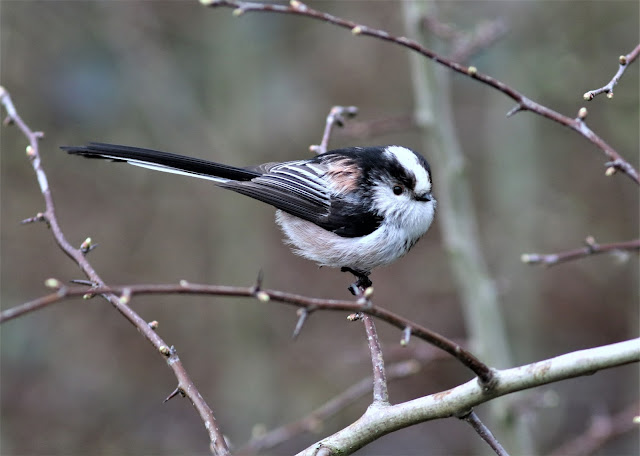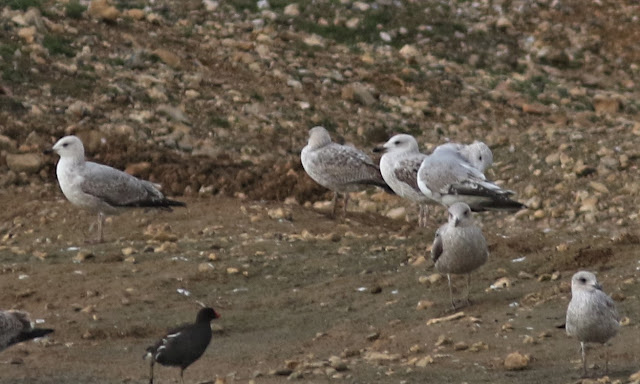Zach found this singing Siberian Chiff at the farmlands today. It was quite a brown/drab looking bird with some Common Chiffchaff like phrases so perhaps a bit of mix singing and maybe something from the transition zone. More sounds on Ebird HERE.
Wednesday, 31 March 2021
'Siberian Chiffchaff' Singing
Tuesday, 30 March 2021
Otmoor- Glossy Ibis again
The Glossy Ibis showed better today. The first sweet singing Willow Warblers too. Ebird list HERE.
Monday, 29 March 2021
Farmoor etc
Decided to do Farmoor this afternoon as not been there for a while and new freedoms started today. Pretty quiet, highlights included the long staying White-fronted Goose, a passage of 125+ Sand Martin heading west, a single Swallow, plenty of Chiffchaffs, a couple of Blackcaps and 11 Goldeneye. Ebird list HERE.
Also did a session by the Ickford Bridges yesterday evening in honour of the longer days, no summer migrants but still quite a few Fieldfares hanging around there. Ebird list HERE. Looks like Ebird hotspots have been set up for various local sites that currently I group under Worminghall area so will start using these but will add any new species to my lockdown area too.
The moth trap was quiet, just an Oak Beauty and Common and Small Quakers.
Sunday, 28 March 2021
Yellow Horned, Early Grey, Golden Plovers and White arses
Saturday, 27 March 2021
A few more migrants
More in coming yesterday at the farmlands, a couple of Blackwits, 35 Sand Martin and a couple of Swallow and today the first Wheatears are in and also a male Firecrest.
Wednesday, 24 March 2021
A few migrants
It's been a good couple of days at Beddington Farmlands with 2 White Storks and a Crane yesterday and a handful of migrants including Ruff, Dunlin, Sand Martins, White Wagtails and Little Ringed Plovers (see my twitter feed below for more from Zach)
I popped over this afternoon and picked up a few scraps.
Tuesday, 23 March 2021
Old Vic Noc Mig
A few sounds from the Old Vic a couple of nights ago HERE. 14 species recorded included Wigeon, Teal, Snipe, Black-headed Gull, Redwing, Fieldfare, Song Thrush, Blackbird and Tawny Owl.
An interesting (for me as still trying to learn these ) comparison of single nocturnal flight calls of Blackbird, Redwing and Song Thrush. Excellent article on Blackbird, Song Thrush and Redwings NFCs HERE .
Had my first summer migrant, a Sand Martin at Otmoor on 22nd March and a check round the airfield and River Thame on 23rd produced little apart from a flock of 96 Stock Dove, a Corn Bunting and plenty of Skylarks in song. Looks like most of the wildfowl have cleared out from the River between the bridges. Ebird lists HERE and HERE.
Sunday, 21 March 2021
Odds and sods from the stomps
What with the persistent northerly putting the knackers on a big push of migrants it's a bit limboland at the moment. Things are picking up on the moth front, winding down on the winter birds, spring migrants are spluttering into action and nobody knows what lockdown even means anymore (the best one is birders popping into see the Mockingbird while they were 'working in the area') . Restrictions lift soon so hopefully just in time for Spring birding travel to actually be legal.
Back in the week day London stomping ground I had the Iceland Gull again on Friday evening and Zach, Anand and I 'did' the Beddington Park Little Owls that night. The singing male by the stock pond is still very vocal.
Meanwhile at the weekend country retreat I had the noc mig and moth trap on last night and did Otmoor today HERE while we've started work in the Old Vic garden too.
Still no proper summer migrant for me.
Wednesday, 17 March 2021
Beddington Farmlands - Adult Iceland Gull
Tuesday, 16 March 2021
Oakley Airfield wildlife in danger?
Very sad to be told today that there will be greatly restricted public access to Oakley Airfield with immediate effect. Security guards with dogs are enforcing the new rules as work begins to develop the site into an autonomous vehicle testing site.
I've had a good read through the Ecological Assessments (including Preliminary Assessments, Environmental Impact Assessment and Biodiversity Impact Assessment for Net Gain) which can be found HERE .
Looks like winter bird survey results are still to be submitted to council and also conditions of the planning application are that a Construction Ecological Management Plan (CEMP) and a Landscape and Ecological Management Plan (LEMP) are produced before development begins.
The ecological consultant recommendations include the aim to achieve 10% net biodiversity gain and a series of habitats to be created in order to mitigate the impacts of the development.
Personally I think this is quite ambitious and there are some very significant factors that need to be taken into account (some which are not included the EIA) . I have pooled my records for Oakley Airfield into a wider Worminghall area Ebird Hotspot HERE. Blog posts and additional local biodiversity surveys adjacent to the airfield can be found HERE. Significant observations include the following:
a) Breeding/summering records of populations of Yellow Wagtails (up to 11, with singing males HERE) and Wheatear (up to 11 but mostly migrating through HERE ) (the Yellow Wagtails and Wheatears were not mentioned by the site ecologists), in addition to Corn Buntings, Grey Partridge, Yellowhammers, Meadow Pipits, Reed Buntings and up to 30 Skylarks (mostly singing males HERE ).
b) Wintering population of up to 700 Golden Plover HERE and 130 Skylarks HERE with wintering Merlin and Peregrines. Also large numbers of winter thrushes.
c) Up to 15 Brown Hare
d) Rarities and scarce migrants (more of a birding interest) - in the last year I have found Dotterel, Firecrest, Greenland Wheatear and Black Redstart
Trying to achieve net biodiversity gain and maintain a population of 700 wintering Golden Plover, 30 pairs of Skylarks, breeding Yellow Wagtails, Corn Buntings, Grey Partridges and all the other birds up there is probably going to be impossible when you consider the scale of the development and the likely impact on the current open extensive habitat which makes the site so special for wildlife- but I guess time will tell.
Never comfortable to read through Ecological Assessments though and see some major aspects missing which are so easy to find by just doing some simple searches on line. Just hope the winter bird surveys are better than the breeding bird surveys. Fingers crossed!

























































